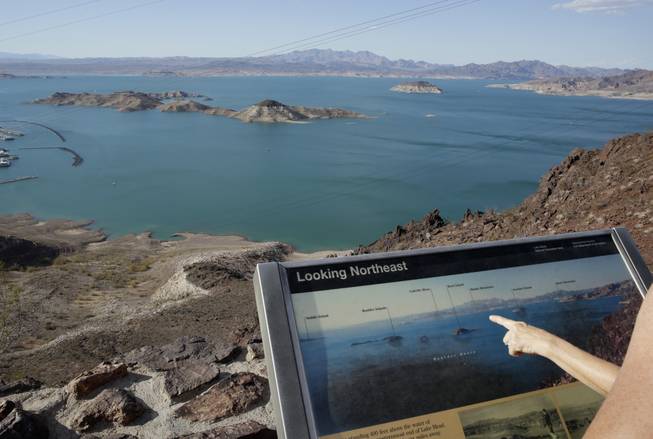
John Locher / AP
In this July 24, 2014, photo, dropping water levels reveal larger islands in Lake Mead compared to a picture on an interpretive sign on a hill overlooking the lake in Lake Mead National Recreation Area.
Monday, April 27, 2015 | 2 a.m.
In the face of a severe ongoing drought, California Gov. Jerry Brown announced mandatory water restrictions to cut water use in his state by 25 percent.
A month after the proclamation, local water agencies already have scaled back water deliveries, and stiff fines are being imposed on those who use more than their allotment. Restaurants aren’t allowed to serve water to customers unless it’s requested, and some communities have put restrictions on emptying and refilling pools.
The restrictions were put into place to try to survive the immediate shortage. But if the drought persists, the state could be forced to enact even more ambitious conservation measures.
If it comes to that, California might want to take a page out of Las Vegas’ playbook. Southern Nevada over the past decade has remade itself as a nationally and internationally recognized leader in water conservation.
Las Vegas was in a situation similar to California’s in 2002, when a persistent drought on the Colorado River began. Southern Nevada had been using more than its allotment to quench the thirst of its rapidly growing population, but the excess water disappeared nearly overnight and leaders had to take quick action.
Over the course of a year, Southern Nevada cut its water consumption by 6 percent, even as the population grew by 60,000 people. That trend continued, and over the past decade, the Las Vegas area has reduced its water consumption by 23 percent, despite adding half a million new residents.
With more than 38 million people, a multibillion-dollar agricultural industry and a complex water system that relies on multiple sources, including the Colorado River, California’s problems are of a different magnitude than those Southern Nevada faced. But the steps taken here offer a road map to making the most out of every drop of water.
Here’s a look at what has worked in Southern Nevada.
Get rid of grass
Southern Nevada’s most successful conservation program by far is the “Cash for Grass” rebate, in which the Southern Nevada Water Authority pays homeowners $1.50 for each square foot of grass that’s replaced with water-efficient desert landscaping.
More than 48,000 homes and 5,250 businesses have taken advantage of the program, ripping up more than 172 million square feet of grass. That translated to 9.6 billion gallons of water saved last year, or about 10 percent of the region’s allocation from the Colorado River.
The water authority has spent more than $200 million on the program, but it’s widely considered an efficient use of money, as thirsty lawns, which are abundant in California, typically are the largest source of water use in a city.
Laws in Nevada also prohibit developers and owners of new homes from planting grass in front yards and limit backyard grass to only 50 percent of the landscaped area. Similar rules exist for new apartments, condominiums and business parks.
Put golf courses on a diet
While many golf courses already use nonpotable reclaimed water to maintain greens and fairways, Southern Nevada’s strict restrictions allow golf courses only 2.1 million gallons of water annually per irrigated acre. That has encouraged golf courses to replace grass that isn’t needed for playing with efficient desert landscaping.
Recycle water
Most of the water that goes down the drain in Southern Nevada is recycled, cleaned and sent back to Lake Mead, where it’s pumped back into the valley and used again without counting against the region’s allotment of the Colorado River. Last year, almost 65 billion gallons of water were recycled locally.
Constructing facilities to enable such a process is expensive, costing tens or even hundreds of millions of dollars, but it prevents huge amounts of water waste. It’s something many California communities are now doing.
Don’t forget the small things
More moderate measures also add up to big savings. Sprinkler use is restricted throughout the year, and water cops patrol neighborhoods to cite people who violate the rules. Personal vehicles can be washed in driveways only once a week, and commercial car washes have to use water-saving technology. Rebate programs reward businesses for using water-efficient toilets and technology, cut the cost of pool covers for consumers and encourage people to install sensors that turn off sprinkler systems when it rains.
What’s being done in Nevada?
Despite Southern Nevada’s conservation efforts, the Western drought threatens the valley’s water supply. It forced the water authority to spend more than $1.4 billion on new infrastructure to keep water pumping out of Lake Mead and prompted Gov. Brian Sandoval to assemble a group of experts to find ways to help Nevada prepare for and weather future water shortages.

Join the Discussion:
Check this out for a full explanation of our conversion to the LiveFyre commenting system and instructions on how to sign up for an account.
Full comments policy